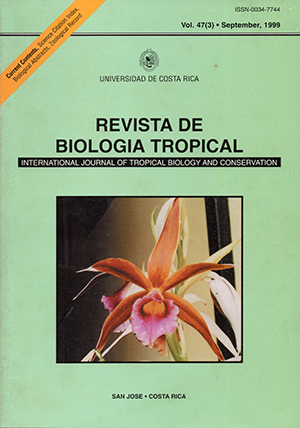Abstract
During one and a half years (February 1991 - Jnly 1992) the growth rhythm and lhe longevity of ¡eaves of 22 abundant understory species in the tropical premontane rain forest of Reserva Biológica Alberto MI. Brenes, Alajnela, Costa Rica, were investigated. Three types of growlh rhythm were identified. Most species, especially the monocotyledones, produce new leaves in defined intervals throughout lhe year. Only sorne have a slower ¡eaf prodnction in lhe dry season. Other species sprout periodically or only once a year. This interval, which is the time period between lhe beginning of the shooting of one leaf and lhe next, varied among lhe investigated species between 17-22 days (Malvaviscus arboreus, Urera elata, Myriocarpa longipes) and more than half a year (Cyclanthus bipal1itus, Iriartea deltoidea, Ocotea gomezii). For sorne species lhis interval was longer at dry and dark sites (M. arboreus), but in many cases microclimatical factors snch as temperature, relative light intensity, and evaporation varied to such a small extent wilhin lhe forest that the differences did not lead to significant influences on growth factors of the plants. The mean leaf longevity varied between a half and four years. The maximum leaf age of the palms Cryosophila warscewiczii, 1. deltoidea and Calyptrogyne trichostachys was estimated to be more lhan five years. In sorne cases leaf age was significantly correlated with microclimatical factors. Leaves of Begonia cooperi growing at higher light inlensities in gaps fel! earlier than lea ves of plants in darker siles in the understory. Generally, lhe longevity of leaves was lower in plants growing at moister sites, but in most cases this relation was nol significant. The data show lhal even in a rather constant climate in the understory of a very moist premontane rain forest, lhere is sorne seasonality in growlh rhythm and that plant growlh varies between different sites within the forest allhough c1imate variations are very small
This work is licensed under a Creative Commons Attribution 4.0 International License.
Copyright (c) 1999 Revista de Biología Tropical

